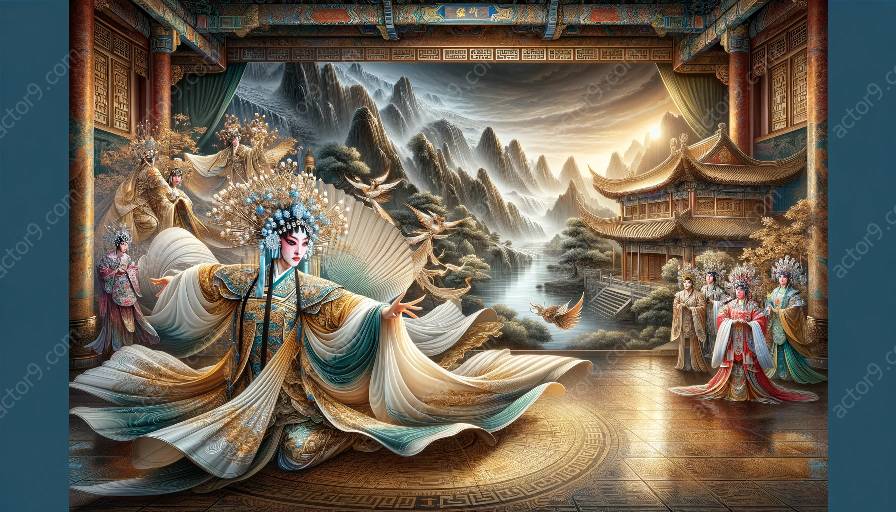Peking Opera, also known as Beijing opera, is a traditional Chinese performing art that combines music, vocal performance, mime, dance, and acrobatics. Staging a Peking Opera performance involves several technical and practical aspects that contribute to its aesthetic beauty and cultural significance. This article explores the key elements of staging Peking Opera performances, from set design and costuming to music and choreography, while also delving into the specific Peking Opera techniques and acting techniques that are integral to the art form.
Peking Opera Techniques
Peking Opera, with its unique blend of singing, acting, and acrobatics, requires a specialized set of techniques that performers must master to convey the rich storytelling and emotional depth of the art form. These techniques include:
- Vocal Techniques: Peking Opera vocal techniques are characterized by a distinct vocal style that incorporates falsetto, chest voice, and vocal ornamentation. Performers use these techniques to convey the emotions and nuances of their characters.
- Martial Arts and Acrobatics: Peking Opera performers undergo rigorous training in martial arts and acrobatics to execute dynamic movements and fight sequences during performances. These techniques require precision, strength, and agility, adding excitement and spectacle to the opera.
- Facial Expressions and Mime: Facial expressions and mime play a crucial role in Peking Opera, with performers using intricate facial movements and gestures to communicate emotions, thoughts, and actions to the audience.
- Movement and Gesture: Peking Opera employs a stylized movement vocabulary that includes formalized gestures, postures, and footwork. These movements are essential for conveying characterizations and storytelling.
Costuming and Makeup
The elaborate costuming and makeup in Peking Opera are integral to the art form, with each character's appearance conveying their social status, personality, and moral character. Performers spend hours preparing their intricate makeup, which often features vividly colored facial patterns that symbolize the characters' traits and emotions. Additionally, the ornate and colorful costumes add to the visual splendor of the performances, enhancing the audience's immersion in the world of Peking Opera.
Role Types and Characterization
Peking Opera features distinctive role types, such as Sheng (male), Dan (female), Jing (painted face), and Chou (clown). Each role type has its own set of conventions and techniques for portraying characters, including specific vocal styles, movements, and gestural patterns. Mastery of these role types is essential for performers to effectively bring their characters to life on stage.
Acting Techniques
Acting in Peking Opera requires a nuanced understanding of Chinese dramatic traditions and performance styles. Performers must embody the emotions, motivations, and conflicts of their characters while engaging with the symbolic and stylized nature of the art form. Key acting techniques in Peking Opera include:
- Emotional Expression: Peking Opera acting involves expressive use of the face, body, and voice to convey a wide range of emotions, from joy and love to anger and sorrow. Performers utilize stylized movements and vocal inflections to evoke emotional resonance with the audience.
- Symbolism and Gestural Language: Peking Opera incorporates symbolic gestures and movements that convey specific meanings and themes. Performers must master the nuanced gestural language of the art form to effectively communicate the subtleties of the narrative and character interactions.
- Role Interpretation and Character Development: Peking Opera performers engage in in-depth character analysis and interpretation to portray the complexities of their roles. Understanding the historical, cultural, and psychological dimensions of their characters is essential for creating compelling and believable performances.
- Interaction with Music and Movement: Acting in Peking Opera is closely intertwined with music and movement, requiring performers to synchronize their emotional expressions and physical gestures with the rhythm and melody of the accompanying music. This harmonious integration of acting, music, and movement enhances the overall impact of the performance.
In conclusion, the technical and practical aspects of staging Peking Opera performances encompass a diverse range of elements, from specialized techniques and costuming to acting traditions and character portrayal. By understanding and appreciating these aspects, audiences can gain a deeper insight into the cultural beauty and artistic complexity of Peking Opera, further enriching their experience of this revered art form.













































